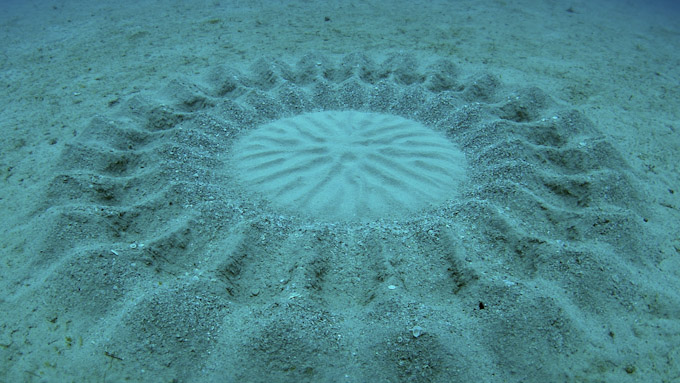Underwater crop circles are no different from above-ground crop circles – they’re both beautiful, captivating and they both have perfectly good rational explanations for their origins. Whereas the traditional crop circles observed in fields of crops are produced by nefarious humans trying to conjure up visits of extra terrestrial beings, the newly discovered underwater crop circles are a form of radial art produced by a different creature trying to garner attention for a real purpose.
Discovered by underwater diver Yoji Ookata off the coast of Japan, the mysterious underwater crop circles look like a single corallite of stony coral blown up to about six feet in diameter. When he first discovered the underwater crop circles Ookata could not believe his eyes, but there’s no reason for humans to create such elaborate features 80 feet underwater where they were extremely unlikely to be noticed by any type of media or journallists. After snapping a few pictures of his first discovery Ookata returned with other divers and some video cameras when they spotted the underwater crop circles being produced by a very unlikely culprit – a tiny pufferfish!
Apparently, a small silvery puffer fish is responsible for making the beautiful and elaborate underwater crop circles and like the mating mounds of Tanganyikan Cichlids, the puffer makes these to attract a mate. With the use of its pectoral fins the male puffer fish carves out an elaborate series of rings and ridges in the sand, and these must be maintained as they are constantly washed away by water flow. The more elaborate the underwater “crop circle” mating ring, the more likely the male puffer is to attract a female counterpart.
The pair of fish lay their eggs in the center of the mating ring and it is hypothesized that the relief of the sand crop circle / mating ring help to affect the water flow in the center where the eggs are laid. As incredible as the natural world already is, it blows us away that such sophisticated natural wonders are just now being uncovered and it just goes to show that we have a lot yet to learn about the 95% of the seafloor yet to be explored. Thanks for the tip Joe R. [Colossal]






